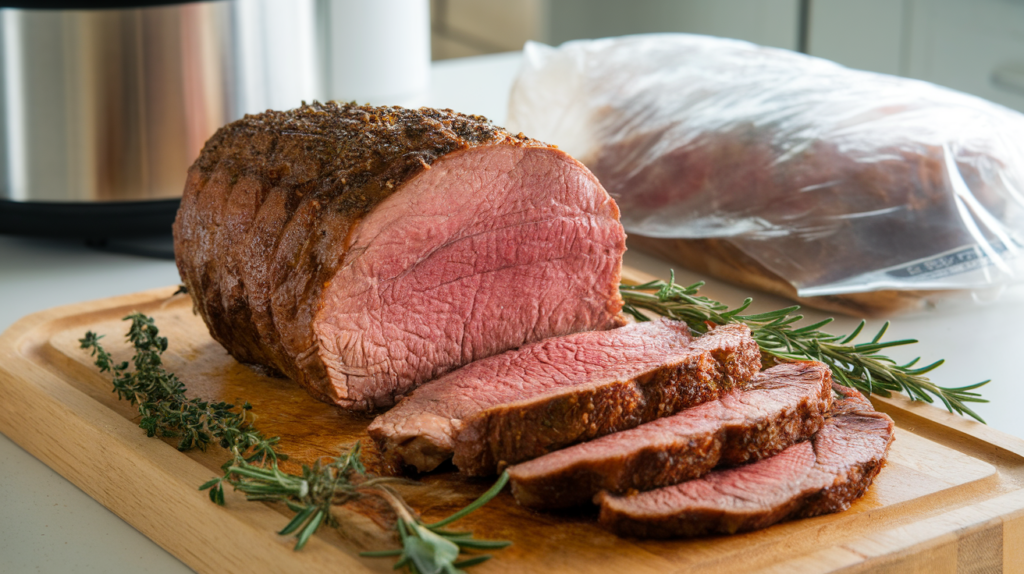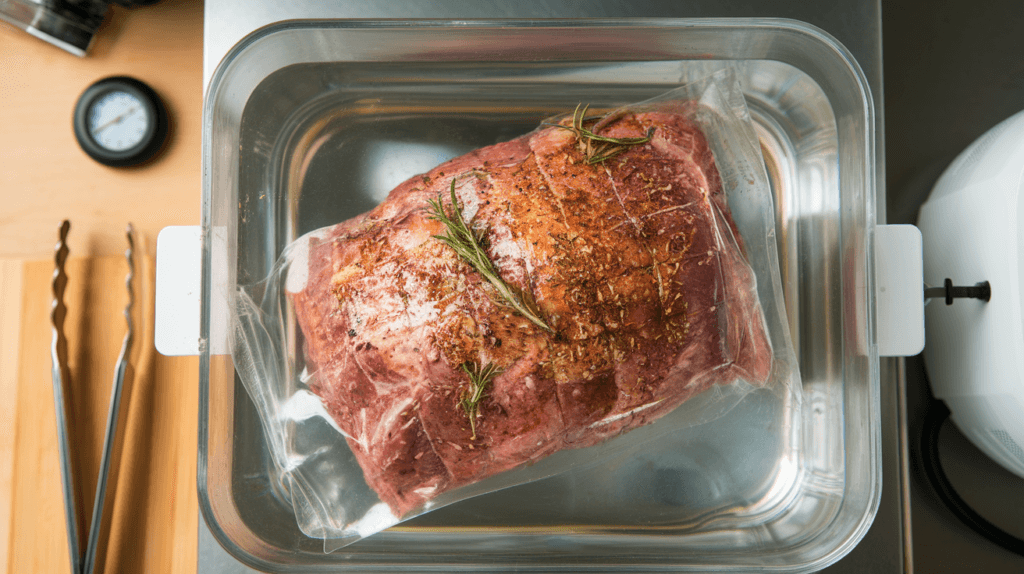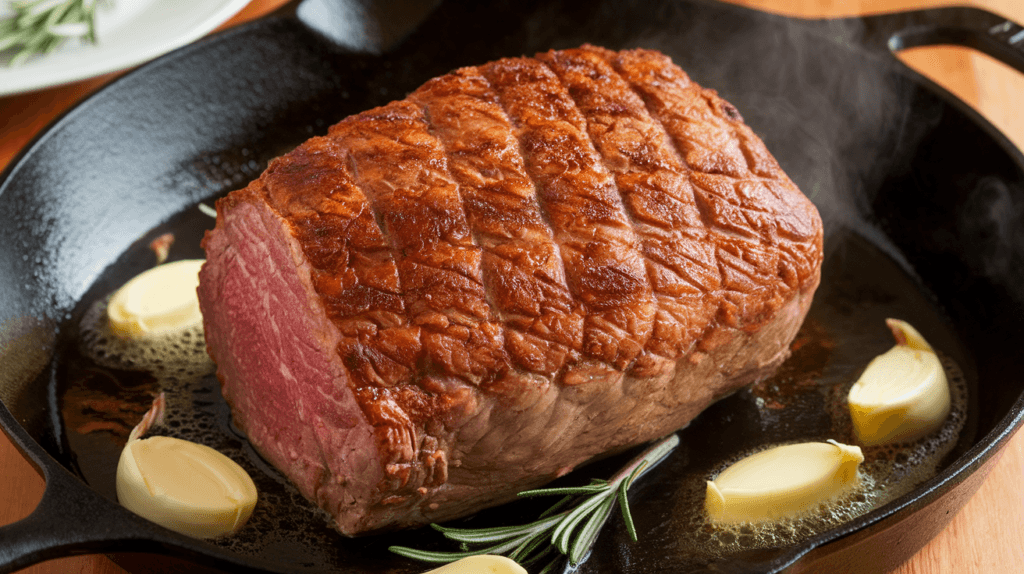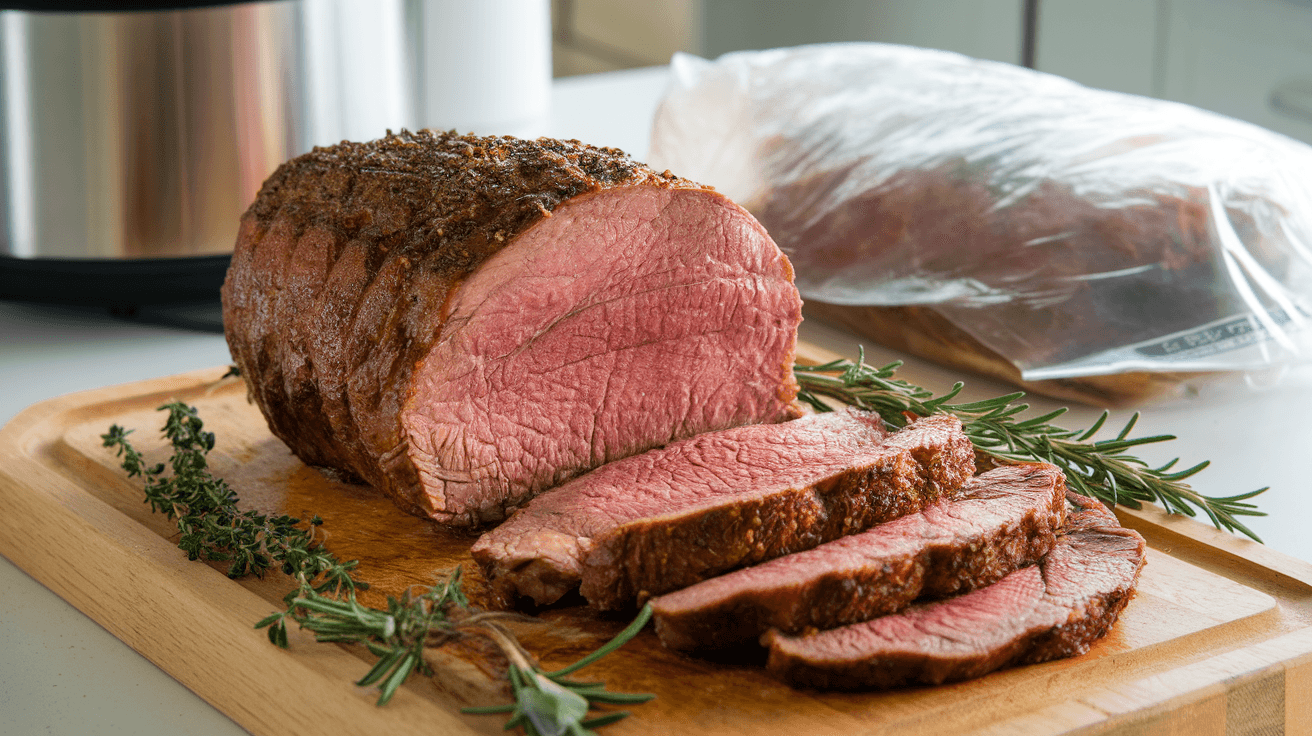Introduction
Sous vide cooking has revolutionized the way we approach preparing meats, offering precision and consistency that traditional methods can’t match. For a 3 lb roast, sous vide allows you to achieve a perfectly cooked piece of meat, tender and juicy, every time. But how long does it take to sous vide a 3 lb roast?
In this article, we’ll delve into the factors influencing sous vide cooking time for a roast, the ideal temperatures for different doneness levels, and tips to ensure your roast turns out perfect. Whether you’re new to sous vide or a seasoned pro, this guide has everything you need to know.

What is Sous Vide Cooking?
Sous vide, which means “under vacuum” in French, is a cooking method where food is placed in a vacuum-sealed bag and immersed in a water bath at a precisely controlled temperature. Unlike traditional cooking methods, sous vide ensures even cooking from edge to center, making it especially popular for meats like roasts.
This technique is renowned for its ability to deliver consistent results, lock in flavors, and retain moisture. It’s a favorite among home cooks and professional chefs alike, transforming how we cook and enjoy meals.
How Does Sous Vide Work?
The sous vide process involves three key steps: vacuum-sealing the food, cooking it in a water bath at the desired temperature, and finishing it with a quick sear or other final preparation methods. This method eliminates guesswork and ensures your roast is cooked to perfection.
Understanding Roast Cuts
Before diving into sous vide cooking times, it’s essential to understand the characteristics of different roast cuts. Not all roasts are the same, and the cut you choose will affect the cooking time and final texture.
Popular Cuts for a 3 lb Roast
- Chuck Roast: Known for its rich marbling, chuck roast becomes incredibly tender when cooked sous vide for extended periods.
- Ribeye Roast: A luxurious choice, ribeye offers tenderness and a buttery flavor that shines with precise sous vide cooking.
- Top Round Roast: Leaner than other cuts, top round benefits from sous vide to avoid dryness and achieve even cooking.
- Sirloin Tip Roast: A versatile and flavorful cut, perfect for sous vide when properly seasoned and seared.
Choosing the Right Roast for Sous Vide
The choice of roast depends on your preference for flavor and tenderness. Cuts like chuck roast and ribeye benefit from longer cooking times, while leaner cuts like top round require careful attention to avoid overcooking.
Why Sous Vide is Ideal for Cooking a 3 lb Roast
Roasts are often challenging to cook evenly using traditional methods like oven roasting or grilling. Sous vide solves these issues by providing precise temperature control, resulting in consistent doneness and exceptional flavor.
Precision Cooking
With sous vide, you can set the exact temperature to achieve your desired level of doneness, from rare to well-done. This level of precision ensures that your roast is cooked perfectly from edge to edge, without the risk of overcooking.
Enhanced Tenderness
The controlled cooking environment of sous vide allows tough cuts of meat to break down slowly over time, resulting in a tender and succulent texture. This makes sous vide an excellent choice for roasts like chuck or brisket.
Flavor Retention
Sous vide cooking locks in juices and flavors by vacuum-sealing the roast. This method prevents moisture loss and intensifies the seasoning, delivering a rich and flavorful result.
How Long Does It Take to Sous Vide a 3 Pound Roast?
The cooking time for a 3 lb roast depends on factors such as the desired level of doneness, the cut of meat, and its thickness. Below is a general guideline for common doneness levels:
Recommended Cooking Times for a 3 lb Roast by Doneness
- Rare (120°F/49°C): Cook for 12-24 hours. The result is a tender and juicy roast with a bright red interior.
- Medium-Rare (130°F/54°C): Cook for 12-24 hours. This is the most popular doneness level, offering a warm red center with enhanced tenderness.
- Medium (140°F/60°C): Cook for 12-24 hours. The roast will have a pink center and slightly firmer texture.
- Medium-Well (150°F/66°C): Cook for 12-18 hours. The meat becomes firmer but retains some juiciness.
- Well-Done (160°F/71°C): Cook for 12-18 hours. The result is fully cooked meat with a firm texture.
Thickness Matters
While weight is a helpful guide, the thickness of the roast plays a more critical role in determining cooking time. Thicker cuts may require slightly longer cooking times to ensure even heating throughout.
Factors Affecting Sous Vide Cooking Time
Several variables influence how long it takes to sous vide a 3 lb roast. Understanding these factors ensures your roast turns out perfectly cooked.
1. Thickness of the Roast
The thickness of the roast is more important than its weight when determining sous vide cooking time. A thicker roast takes longer to heat evenly throughout compared to a thinner cut.
2. Type of Cut
Different cuts of meat have varying amounts of connective tissue and marbling, which impact the cooking time. Tough cuts like chuck roast require longer cooking times to break down collagen and become tender.
3. Desired Doneness
The level of doneness you prefer will determine the water bath temperature and cooking duration. Lower temperatures require longer cooking times to achieve rare or medium-rare, while higher temperatures cook faster but may result in firmer textures.
4. Starting Temperature
The initial temperature of the roast—whether it’s refrigerated or at room temperature—affects how long it will take to reach the desired doneness. A cold roast requires more time to heat evenly.
5. Equipment and Water Circulation
Using a high-quality sous vide circulator ensures consistent water temperature and circulation, which is crucial for even cooking. Ensure your water bath is deep enough to submerge the entire roast.
Step-by-Step Guide to Sous Vide a 3 Pound Roast
Follow these steps for a foolproof sous vide roast:
1. Prepare the Roast
Start by selecting a fresh 3 lb roast of your preferred cut. Trim excess fat and silver skin, as these do not break down in sous vide cooking.
2. Season Generously
Season the roast with salt, pepper, and any desired herbs or spices. You can also add garlic, rosemary, or thyme for enhanced flavor. Optionally, marinate the roast for a few hours before vacuum-sealing.
3. Vacuum-Seal the Roast
Place the seasoned roast in a vacuum-seal bag or a resealable freezer bag using the water displacement method. Remove as much air as possible to ensure even cooking.
4. Set the Sous Vide Temperature

Set your sous vide circulator to the desired temperature based on your preferred level of doneness. Refer to the temperature guide mentioned earlier for precise settings.
5. Cook the Roast
Immerse the sealed bag in the water bath, ensuring it is fully submerged. Cook the roast for the recommended time, usually between 12 to 24 hours depending on the cut and doneness.
6. Finish with a Sear
Once the roast is cooked, remove it from the bag and pat it dry with paper towels. Sear it in a hot skillet with a bit of oil to develop a flavorful crust. Alternatively, use a torch for a quick and even sear.
7. Slice and Serve
Allow the roast to rest briefly before slicing. Serve with your favorite sides and enjoy a perfectly cooked, flavorful meal.
Temperature and Time Chart for a 3 lb Roast
To make sous vide cooking easier, here’s a temperature and time chart tailored for a 3 lb roast. Use this guide to achieve the perfect doneness:
| Doneness Level | Temperature | Cooking Time |
|---|---|---|
| Rare | 120°F (49°C) | 12-24 hours |
| Medium-Rare | 130°F (54°C) | 12-24 hours |
| Medium | 140°F (60°C) | 12-24 hours |
| Medium-Well | 150°F (66°C) | 12-18 hours |
| Well-Done | 160°F (71°C) | 12-18 hours |
Tips for Perfect Results
Mastering sous vide cooking requires attention to detail and a few key techniques. Here are tips to ensure your 3 lb roast is flawless every time:
1. Use High-Quality Equipment
Invest in a reliable sous vide circulator for consistent temperature control. Ensure your water bath is large enough to accommodate the roast comfortably.
2. How to Season a 3 Pound Roast Generously for Sous Vide
Don’t be shy with seasonings. Sous vide locks in flavors, so herbs, spices, and marinades will have a significant impact on the final taste.
3. Pat Dry Before Searing
After cooking, remove the roast from the bag and pat it dry with paper towels. A dry surface ensures a crisp, golden-brown crust during searing.
4. Searing Your Sous Vide 3 lb Roast with a Cast-Iron Skillet
For the best sear, use a preheated cast-iron skillet with a small amount of high-smoke-point oil, such as canola or avocado oil.
5. Avoid Overcrowding the Water Bath
If cooking multiple items, ensure there’s enough space for water to circulate freely around each bag. This ensures even cooking.
6. Finish with a Compound Butter
Add a dollop of herb-infused butter during the searing step for an extra layer of flavor and richness.
7. Rest Before Slicing
Allow the roast to rest for a few minutes after searing. This helps redistribute the juices, ensuring every slice is succulent and flavorful.
Troubleshooting Common Sous Vide Issues
Even with the precision of sous vide cooking, challenges can arise. Here are solutions to common problems:
1. Roast Feels Too Mushy
Overcooking, even with sous vide, can lead to an overly soft texture. Stick to the recommended cooking times and avoid exceeding 24 hours for most roasts.
2. Uneven Cooking
If parts of the roast feel undercooked, ensure the water bath maintains a consistent temperature and that the roast is fully submerged. Use a reliable sous vide circulator for precision.
3. Water Bath Loses Heat
Cover the water bath with a lid or plastic wrap to prevent heat loss. This is especially important for long cooking times.
4. Roast Lacks Flavor
If the meat seems bland, enhance the seasoning or consider marinating the roast before vacuum sealing. Adding aromatics like garlic, rosemary, or thyme can elevate the flavor.
Enhancing Flavor and Presentation
Once your 3 lb roast is perfectly cooked using sous vide, it’s time to focus on elevating its flavor and presentation. These extra touches can make your dish unforgettable, whether for a family dinner or a special occasion.
1. How to Create a Perfect Sear for a Sous Vide 3 lb Roast

The sear is the finishing touch that adds a delightful crust and enhances the roast’s flavor. Use a preheated cast-iron skillet, high-smoke-point oil (like avocado or grapeseed oil), and sear each side for 1-2 minutes. For even more depth, add a pat of butter, garlic cloves, and fresh herbs during the searing process.
2. Sauces and Gravies
Pair your roast with a rich sauce or gravy to complement its flavors. Here are some ideas:
- Red Wine Reduction: Simmer red wine, beef stock, and shallots until thickened.
- Mushroom Cream Sauce: Combine sautéed mushrooms, cream, and a touch of Dijon mustard.
- Herb-Infused Jus: Use the juices from the vacuum-sealed bag, reduced with rosemary and thyme.
3. Garnishes for Presentation
Visual appeal is just as important as taste. Use fresh herbs like parsley or thyme for a pop of color. Thinly sliced roasted garlic or caramelized onions also make excellent garnishes.
4. Perfect Pairings
To make your roast shine, serve it alongside complementary dishes. Some crowd-pleasing options include:
- Roasted garlic mashed potatoes
- Buttery green beans with almonds
- Grilled asparagus with lemon zest
- Honey-glazed carrots
5. Serving Suggestions
Slice the roast against the grain to ensure maximum tenderness and serve it on a warmed platter. Arrange the slices attractively, drizzle with sauce, and garnish with herbs for a professional presentation.
6. Storing Leftovers
If you have leftovers, store them in an airtight container in the refrigerator for up to 3 days. To reheat, use sous vide at the original cooking temperature to maintain the roast’s texture and doneness.
Frequently Asked Questions
1. Can I sous vide a frozen 3 lb roast?
Yes, you can sous vide a frozen roast. Simply add 1-2 extra hours to the cooking time to ensure it heats evenly.
2. Do I need to use a vacuum sealer?
While a vacuum sealer is ideal, you can use the water displacement method with a resealable freezer bag for similar results.
3. Can I use sous vide for tough cuts of meat?
Absolutely! Tough cuts like chuck roast or brisket benefit greatly from sous vide, as the extended cooking times break down connective tissue for a tender result.
4. How do I reheat a sous vide roast?
To reheat, use the sous vide method at the original cooking temperature for 1-2 hours. Avoid reheating above the initial temperature to maintain doneness.
5. What sides pair well with a sous vide roast?
Sous vide roasts pair beautifully with mashed potatoes, roasted vegetables, creamy polenta, or a fresh salad.
6. Is it safe to cook meat in a plastic bag?
Yes, as long as you use food-safe vacuum bags or BPA-free freezer bags designed for sous vide cooking.
Conclusion
Sous vide cooking offers an unparalleled way to prepare a 3 lb roast, delivering perfect doneness, tenderness, and flavor every time. By following the recommended times and temperatures, you can confidently create a roast that’s sure to impress your family or guests.
Whether you’re new to sous vide or an experienced cook, this method guarantees consistent results with minimal effort. Embrace the precision and convenience of sous vide, and elevate your roast to a whole new level of culinary perfection.

